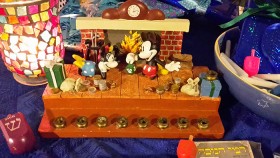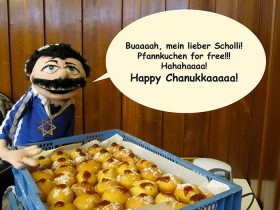— the Hanukkah Message?

Mice with a vice
Photo: CC-BY Michal Friedlander
I have been using the same Hanukkah lamp for nearly 20 years. I find it aesthetically-challenging and totally impractical: it is difficult to clean and the candles fall out. Yet I persist in using it because it provokes me to think. When I put the illuminated, figurative lamp on the windowsill to publicly “proclaim the Hanukkah miracle of light,” the same three questions always resurface in my mind: “Who designed this lamp?,” “What were they thinking?,” and, “Are Mickey and Minnie Mouse actually Jewish?” → continue reading

One of the hand puppets from Shlomit Tulgan’s bubales family saying “Oooh, my oh my! Hotcakes for free!!!”
CC-BY Shlomit Tulgan
I was asked recently if I could write something about how I celebrate Hanukkah in my own circle of family and friends. It occurred to me that the last time I spent Hanukkah with friends or with my parents was quite awhile back. I rummaged around through old photos until I found a picture of me with my father in 1988, lighting our Hanukkah candelabrum: we had just applied for political asylum in West Berlin and were allowed to stay with friends, so we didn’t have to remain longer in refugee quarters. For me back then, Hanukkah was a personal, family thing. → continue reading
Impressions of the “Obedience” Exhibition, from Muslim and Christian Perspectives
During the recent “Long Night of Museums” event, visitors were given a unique introduction to our current temporary exhibition “Obedience. An Installation in 15 Rooms by Saskia Boddeke & Peter Greenaway,” when the imam Emine Erol and the pastor Silke Radosh-Hinder led guided tours together. We asked the two women what they made of the occasion, and whether the joint guided tours had opened up novel views and perspectives on the biblical story.
Ms Erol, Ms Radosh-Hinder, would each of you describe the exhibition in your own words?
Silke Radosh-Hinder: For me, the exhibition is above all an opportunity to examine the story of the Binding of Isaac from a myriad of perspectives.
Emine Erol: The primary focus of the Obedience exhibition is the frame of mind of Ismael/Isaak respectively of his father Abraham. By prompting an emotional response and reflection, it helps visitors understand, ultimately, that such surrender may be dangerous or possibly even fatal—and also to understand what may motivate it. → continue reading

